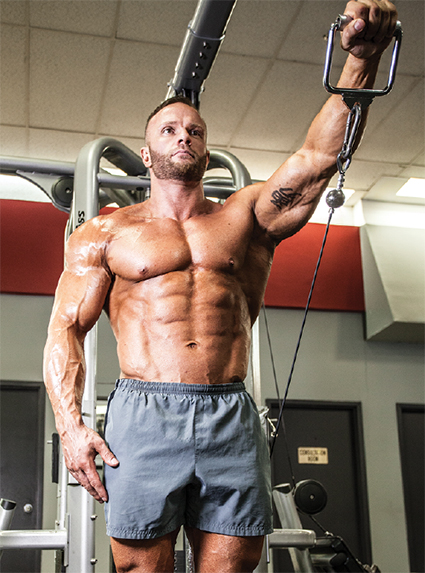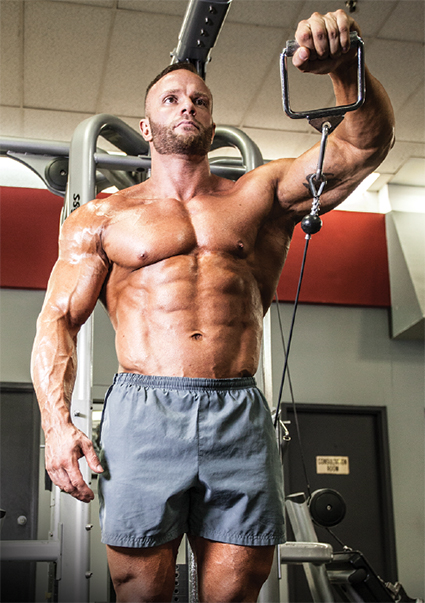Bill Geiger

Bill Geiger, MA, is Editor of Muscle Insider. He was formerly Editor of Muscle & Fitness magazine (U.S.) for 14 years and Group Editorial Director of MuscleMag (Canada) and Reps. The California native also served as Senior Content Editor for three years with Bodybuilding.com, earning two Article of the Year honors from the website. Now living in Las Vegas, Bill received his bachelor’s degree with honors in economics from Occidental College in Los Angeles and his master’s in physical education from the University of Southern California. He has written over 1,000 training articles. He’s also covered college football and basketball as a sportswriter. His website is BillGeiger.US.

Extend Your Arm for Better Overload
It’s possible to make a given weight feel heavier—or lighter—by how close you hold it to your body. Here’s how that can adversely affect muscle gains.
When is a 40-pound dumbbell not 40 pounds? Yeah, that sounds like a trick question because, well, we’re not doing biceps curls on the moon. But humour me and take this test: Hold that weight with a neutral grip at chest height right next to you and then, after a couple of minutes’ rest, again at arm’s length. Hold each for 30 seconds. Was one harder than the other?
Something must be going on, and if you’re a student of physics, you likely know why. (And if you’re a bodybuilder who likes to use cheating form, you’ve likely discovered this one, too.) The fact is, holding a weight away from your body feels heavier than if you hold it close, even when it’s the exact same weight.

Here’s why. Load isn’t the sole factor determining the force that’s applied on your shoulder joint when holding up the weight; so too is a concept called torque. Torque essentially means that the force applied by the dumbbell on your shoulder joint is multiplied the further your arm is extended. This is sometimes referred to as having a longer lever arm.
For single-joint movements such as front or lateral raises, shortening the distance the weight is from your body, as when holding your arm in an L position, makes the movement easier than if you keep it almost straight. Anyone who in fact does these exercises with highly bent arms has found a shortcut to making the movement easier—all the while convincing themselves they can handle the heavier load.
There’s plenty of evidence of this concept in action at the gym among trainers who do lateral-raise or front-raise movements with highly bent arms. (Don’t confuse this with bendingor extendingthe elbow duringthe motion but, rather, keeping the elbow highly bent for the duration of the set.) If you’ve always locked a very slight bend in your elbows and suddenly switch to the highly bent version, you may convince yourself you’ve gained strength and are in need of greater resistance when in fact all you’ve done is found an easier way to execute the motion. In fact, gym bros often find ways to do exercises without really having to lift heavier weights, a sight that surely looks good in the mirror.
 This same concept regarding lever length also comes into play on leg day, especially with exercises such as lying leg curls and leg extensions. Some machines have adjustable lever lengths, and it’s tempting to opt for the shorter one. But when you shorten it, meaning that the padded bar is higher up and closer to your knees rather than farther down by your feet, you also affect torque and the resultant force on the target muscle group.
This same concept regarding lever length also comes into play on leg day, especially with exercises such as lying leg curls and leg extensions. Some machines have adjustable lever lengths, and it’s tempting to opt for the shorter one. But when you shorten it, meaning that the padded bar is higher up and closer to your knees rather than farther down by your feet, you also affect torque and the resultant force on the target muscle group.
As far as dedicated hardcore lifters are concerned, there’s never a good reason to make an exercise easier. You grow by increasing the overload, not reducing it.
Get articles like this one delivered to your email each month by signing up for Muscle Insider’s mailing list. Just click here.

